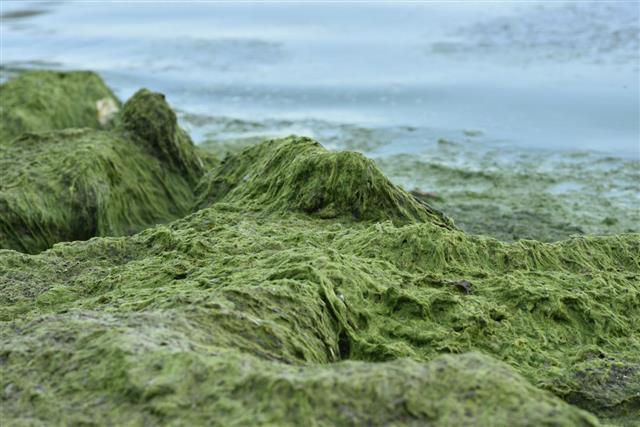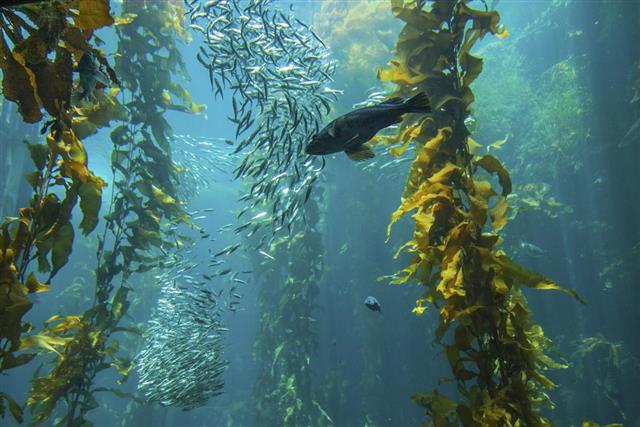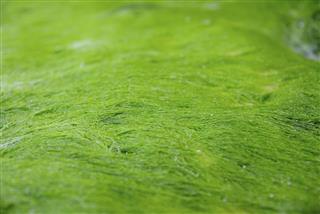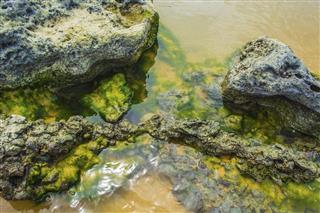
Algae belong to the kingdom Protista, and are simple photosynthetic organisms. Based on the occurrence of pigments and food reserves, algae are classified into different types, namely blue green algae (BGA), green algae, red algae, and brown algae.
Algae are simple, autotrophic organisms, which can synthesize their own food by means of photosynthesis. Their taxonomy is very confusing. Previously, algae were classified under the kingdom Plantae, as they possess chlorophyll for photosynthesis. However, algae are mostly aquatic, and lack true roots, stems, and leaves, which are not so in plants. Hence, in the modern classification, they are excluded from Plantae, and categorized under Protists. Their size may range from few micrometers to several meters. For example, the freshwater alga Micromonas is about 1 micrometer, whereas the giant marine kelp can grow to about 60 meters in length. The branch of science that deals with the study of algae is called phycology, and those who specialize in this study are known as phycologists.
Algae Types
The differences in the pigments play a major role in determining the habitat distribution of the particular algal species. Regarding their distribution, they can adapt in diverse environmental conditions. Majority of algae are found in aquatic habitats, either in freshwater or marine water. Some species are found in extreme environment like snow and ice, whereas some are adapted towards hot springs.
Blue Green Algae (BGA)
Blue green algae (BGA), also referred to as cyanobacteria, are the simplest forms of algae. Examples of BGA are Nostoc and Calothrix. As the name suggests, they are blue green in color, ranging from single-celled organizations to colonial forms. BGA contain chlorophyll ‘a’, ‘b’, and phycobilins. They are prokaryotic in cellular organizations that resemble bacteria. BGA are considered to be an intermediate between bacteria and plants. Hence, the name cyanobacteria is assigned to these species. Since they lack specialized organelles, they photosynthesize directly through the cytoplasm.
Green Algae
They belong to the phylum Chlorophyta, and they contain chlorophyll ‘a’, ‘b’, carotenoids, and xanthophylls. Their main food reserve is starch. Some examples of this type are Ulva, Codium, and Caulerpa. As of now, about 7000 species of green algae have been identified. They may be either unicellular or multicellular. Most of them are freshwater algae, while a few species are found in the marine water.
Red Algae
They belong to Rhodophyta, and they contain chlorophyll ‘a’, ‘d’, carotenoids, xanthophylls, and phycobilins. Their food reserve is floridean starch. The examples of red algae are Chondrus and Gelidiella species. Majority of the varieties are marine species. More than 6500 species of red algae have been identified, out of which about 200 are freshwater species. The red pigment called phycobilin helps in harvesting light at a greater depth. Hence, some members of this type are found at such depths in the ocean floor, where no other photosynthetic organisms can adapt.
Brown Algae
They belong to the class Paeophyceae, and they contain chlorophyll ‘a’, ‘c’, and fucoxanthin pigment. Due to the green colored chlorophyll and brown pigment called fucoxanthin, the members belonging to this class exhibit a typical greenish-brown coloration. Their food reserves are complex carbohydrate polymers called laminarin. Laminaria and Macrocystis are the examples of brown algae. Similar to red algae, majority of these algal groups are adapted to marine water. Brown algae are the most complex ones, wherein some species are adapted at certain depths in the seas and oceans. The giant kelps found on the ocean floor are brown algae belonging to the order Laminarales. Kelps are the only ones of this type that exhibit tissue differentiation.
Algal species are very sensitive to the changes in environmental conditions. Hence, they are used as biological indicators to determine any modification in the environment. For example, simple freshwater algae like Euglena and Chlorella are used to indicate the extent of water pollution.




